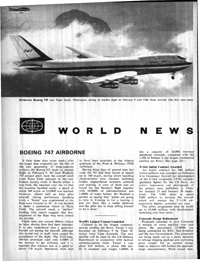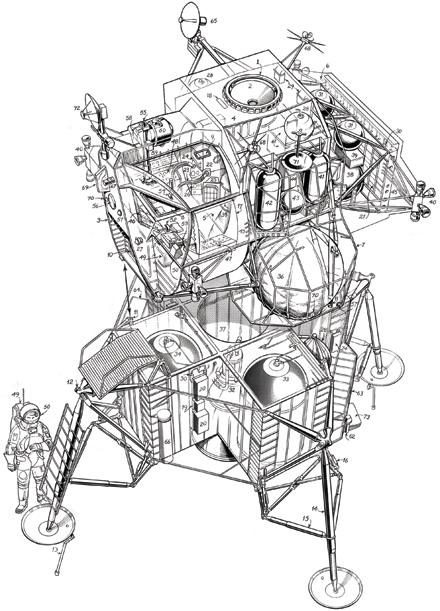
By Günter Endres
The jet age had truly arrived. The Boeing 707, Douglas DC-8, Comet 4, Sud AviationCaravelle and Tupolev Tu-104 were soon joined by other types such as the BAC One-Eleven, Hawker Siddeley Trident, Boeing 727 and 737, Fokker F28, McDonnell Douglas DC-9 and Vickers VC10. The Soviet Union produced the Ilyushin IL-62, Tupolev Tu-134 and Tu-154, and the Yakovlev Yak-40. Some evolved into successful aircraft families.
But the most eye-catching civil aircraft took flight on 9 February 1969. The giant Boeing 747 with its distinctive upper deck made use of the new big-fan engines being developed in the USA and UK that would underpin the new breed of widebody airliners being developed. The 747, or "Jumbo Jet", doubled the capacity offered by airliners to more than 450 passengers, was the world's first widebody, and to date, remains the best selling.
 |
|---|
| 9th February 1969 - The Jumbo Jet era begins |
As the jet took control of the world's air routes, so the sight and sound of propeller-driven airliners began to disappear. The piston propliners of the 1950s were quickly made obsolete by the 707 and DC-8 and by the 1960s, short-haul jets stopped the progress of big turboprops such as the Vickers Vanguard and Lockheed Electra in their tracks. Forget the efficiency savings offered by turboprops, it was speed that was the order of the day.
The jet craze did not prevent the Soviets giving propellers one last hurrah, with the development of the 200-passenger Tupolev Tu-114. Powered by four Kuznetsov turboprops with contra-rotating propellers, the aircraft could fly at a near-jet speed of 415kt (768km/h). The Tu-114D version was specially adapted to fly non-stop between Russia and Cuba. The giant Antonov An-22 also used contra-rotating propellers and was the world's largest aircraft until the advent of the US-built C-5 Galaxy military airlifter.
RECOVERING FROM COMET
While Europe's fragmented aviation industry still tried to recover from the setback of the Comet crashes in the 1950s, it was the USA that continued to dominate the subsonic airliner market. Its supremacy was finally challenged by Europe in 1974 - although few would have believed it at the time - when the multinational Airbus A300 entered service with Air France. The design, which was the world's first widebody twinjet, took on the established Lockheed TriStar and McDonnell Douglas DC-10 trijets, whose third engines proved a cost liability as the energy crisis hit in the mid-1970s. Through developing a family concept, covering a wide range of capacities, Airbus threw down the gauntlet to Boeing, eventually matching and then surpassing the US manufacturer in output three decades after the A300's debut.
The "Jump Jet" became a reality on 12 September 1961, when the British experimental Hawker Siddeley P.1127 made the first complete transition from vertical to horizontal flight via thrust vectoring. It was developed into the Harrier, still the only truly successful design of this type of aircraft from the many projects of the 1960s. Vertical take-off in the form of rotorcraft also came of age, with helicopters such as the Bell UH-1 Huey and AH-1 HueyCobra proving their capabilities in the exacting theatre of the Vietnam war. An impressive array of helicopters were produced in this period by Aerospatiale in France, Mil in Russia, which built the largest types such as the Mi-6 and Mi-12, Boeing with its Chinook, and Sikorsky in the USA with the CH-53 Sea Stallion and S-61/SH-3 Sea King among others.
PACKAGE HOLIDAYS
A new experience in mass travel was pioneered in the UK, when Universal Tours and its own airline Euravia offered the first integrated inclusive-tour holiday package at prices that undercut those of the established airlines. More British airlines followed suit in flying holidaymakers to the sunspots on the Mediterranean, a concept that later became established in other European countries. One man in particular embodied the quest for cheap air travel. Freddie Laker founded his airline on 8 February 1966 and was among the first to adopt the no-frills business model, later taken up with even greater success in the USA by Herb Kelleher with Southwest Airlines. Laker introduced the first daily Skytrain low-fare scheduled service between London Gatwick and New York Kennedy on 1 September 1977. The first aerial hi-jacking by terrorist groups in the 1970s added a new, unwelcome, dimension to air transport.
The 1960s was a very productive time, with new aircraft that enabled the expansion of the air transport envelope. The first small jets dedicated to business travel made their appearance, attracting custom from what are now known as high net-worth individuals and corporate owners. William Lear started his successful Lear Jet family, which is still going strong, but the first aircraft to address this new sector of travel were the North American Sabreliner and de Havilland's DH125. Dassault, Cessna and Gulfstream jumped on the bandwagon soon after and eventually dominated the market. Private flying also accelerated as manufacturers offered a multitude of types to suit all tastes, with Beechcraft, Cessna and Piper particularly prominent.
ENDLESS CHOICE
Armed forces too were being equipped with a seemingly endless choice of fighters, bombers, trainers and support aircraft, many of which stretched performance to new heights. The UK's highly advanced tactical strike and reconnaissance bomber, the TSR.2, made its maiden flight on 27 September 1964, but was unfortunately killed off the following year. More successful was the military surveillance derivative of the Comet, the Nimrod, which entered service in 1969 and is now being re-engineered for several more decades of operation.
Other military aircraft that caused a stir and survived included the super-fast and highly manoeuvrable Boeing (nee McDonnell Douglas) F-15 Eagle, F-4 Phantom, Dassault Mirage, General Dynamics F-111, English Electric Lightning, Anglo-French Jaguar, and theawesome Rockwell B-1 bomber. The Russians dazzled with the MiG-21 Fishbed, the swing-wing MiG-23 Flogger and the MiG-25 Foxbat, as well as the Tupolev Tu-22M Backfire bomber.
NEED FOR SPEED
The quest for still faster "Mach busters"remained undiminished and, in 1967, the experimental, rocket-powered X-15, a joint effort between NASA and the US Air Force, reached a record speed of Mach 6.72 at an altitude of 67 miles (108km), but the fastest operational aircraft to fly within the Earth's atmosphere is still the Lockheed SR-71A Blackbird spyplane, which first flew on 22 December 1964 and could reach speeds of above Mach 3 (2,200mph-plus).
While some civil airframers believed large capacity was the way forward, others were excited by the idea of flying passengers beyond the speed of sound. In 1962 France and the UK brought together their supersonic airliner studies to jointly produce a Mach 2 capable airliner that would ultimately materialise as the Aerospatiale/BAe Concorde.

Concorde, the ultimate development of the airliner in the 20th century, entered service in 1976
The 100-seater took to the air on 2 March 1969 and entered service simultaneously with Air France andBritish Airways on 21 January 1976. However, Concorde had been beaten into the air by the Soviets' Tupolev Tu-144, which had taken off on its maiden flight on 31 December 1968. The more ambitious US project, the Boeing 2707, had fallen by the wayside, but that did not stop the covert and blatantly overt manoeuvring across the Atlantic to put obstacles in the way of Concorde.
On 12 April 1961, Soviet cosmonaut Yuri Gagarin aboard Vostok 1 became the first human in space and the first to orbit the Earth, followed a month later by US astronaut Alan Shepard. It was the prelude to a race between the two super-powers to put a man on the Moon, which the USA "won" on 20 July 1969, when Apollo 11 commander Neil Armstrong set foot on Earth's nearest orbiting body.

The ultimate expression of aerospace design? The Lunar Module went to the Moon in 1969
US interest in the Moon missions then waned as NASA got excited about the prospect of developing a spaceplane that could blast off to Earth orbit. The Soviets, having abandoned plans for a lunar landing, continued to test out new spacecraft and became the first to create what would be a long line of orbiting manned space stations.
Günter Endres is a freelance journalist and a regular contributor to Flight International and Airline Business, and edits our annual World Airlines Directory
Continue reading The Flight Century
Chocks away - 1909 - 1918
Britsh aviation made a slow start, but within the decade the country was making aircraft and the RAF had formed
Peace ... and war - 1919 - 1939
The inter-war years were a time of renaissance, innovation and record breaking and the creation of the air travel industry
Fight for the edge - 1939 - 1948
The Second World War brought aerospace innovation on both sides, but the sound barrier remained intact until 1947
Flying into a jet age - 1949 - 1958
Despite its problems, the Comet was a revolution in air transport. But this would be a decade of firsts, many of them British
Electric jets and stealth - 1979 - 1999
Innovations of the 1980s brought far-reaching changes in virtually every area of aviation - and Flight became truly International
Flight 100 - history of 21st century
As we entered the 21st century fuel efficiency and green design were beginning to take over from the quest for size and speed
Flight into the future - The next 100 years
We covered exciting, almost unbelievable, breathtaking developments in our first century of publishing. What might feature on our pages in the next 100 years?

Source: Flight International













